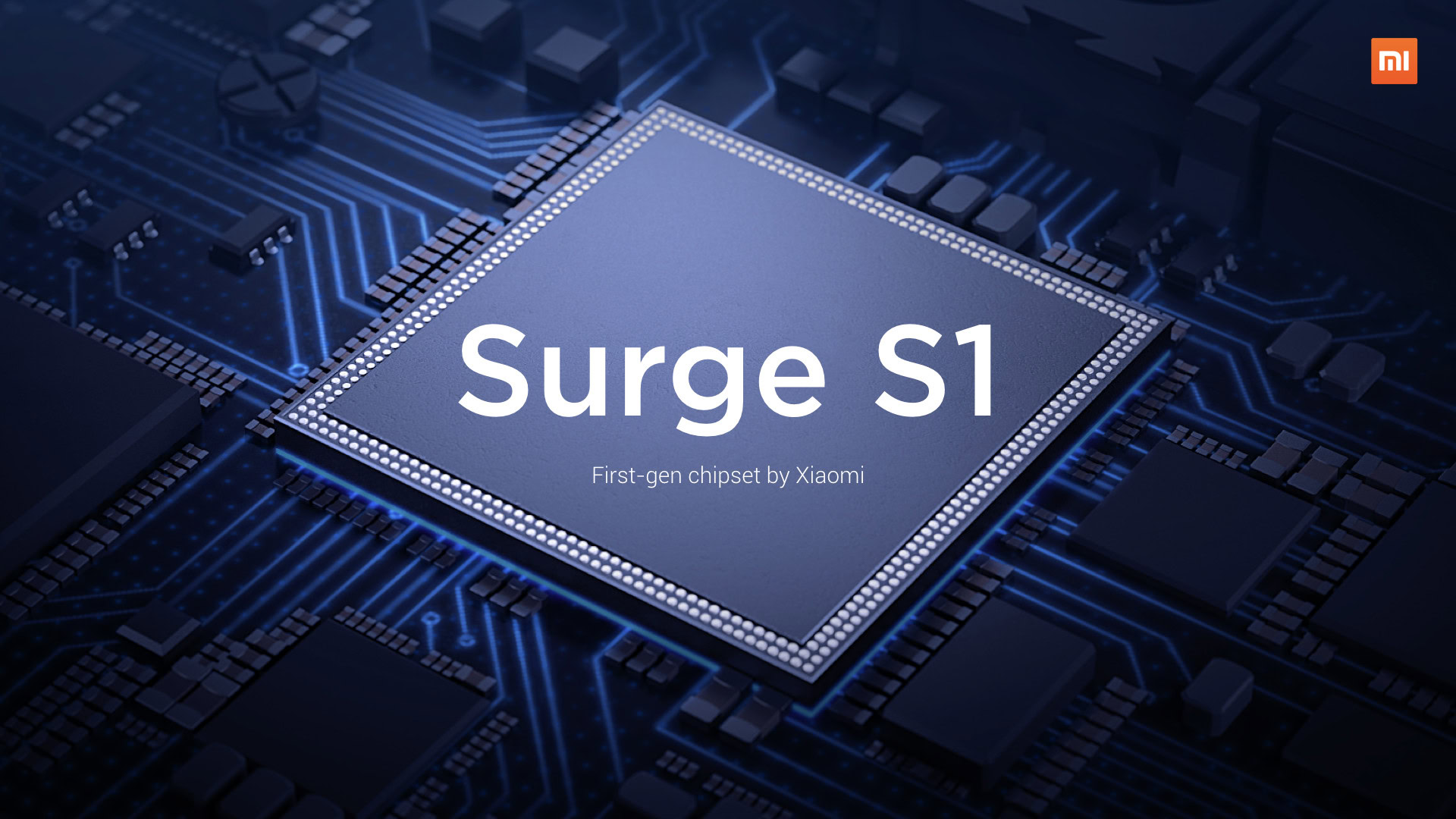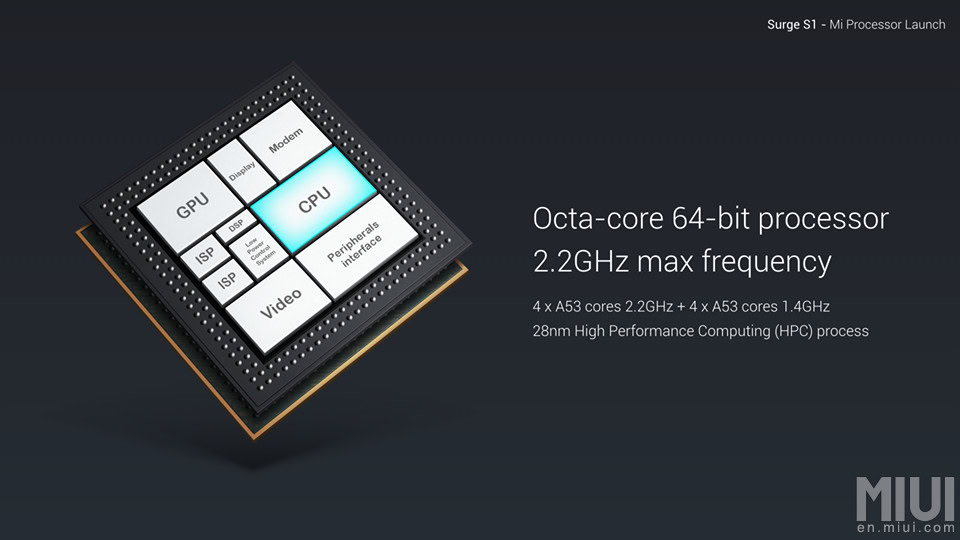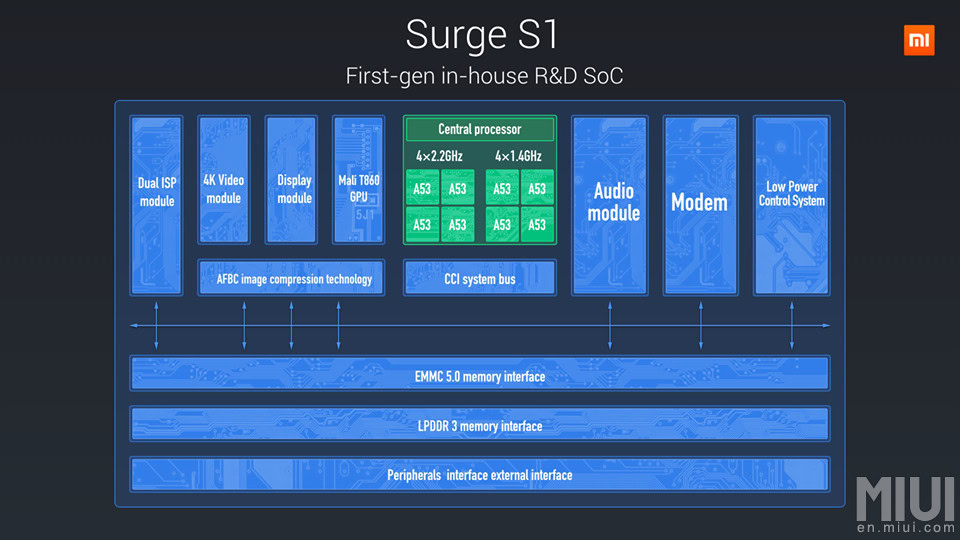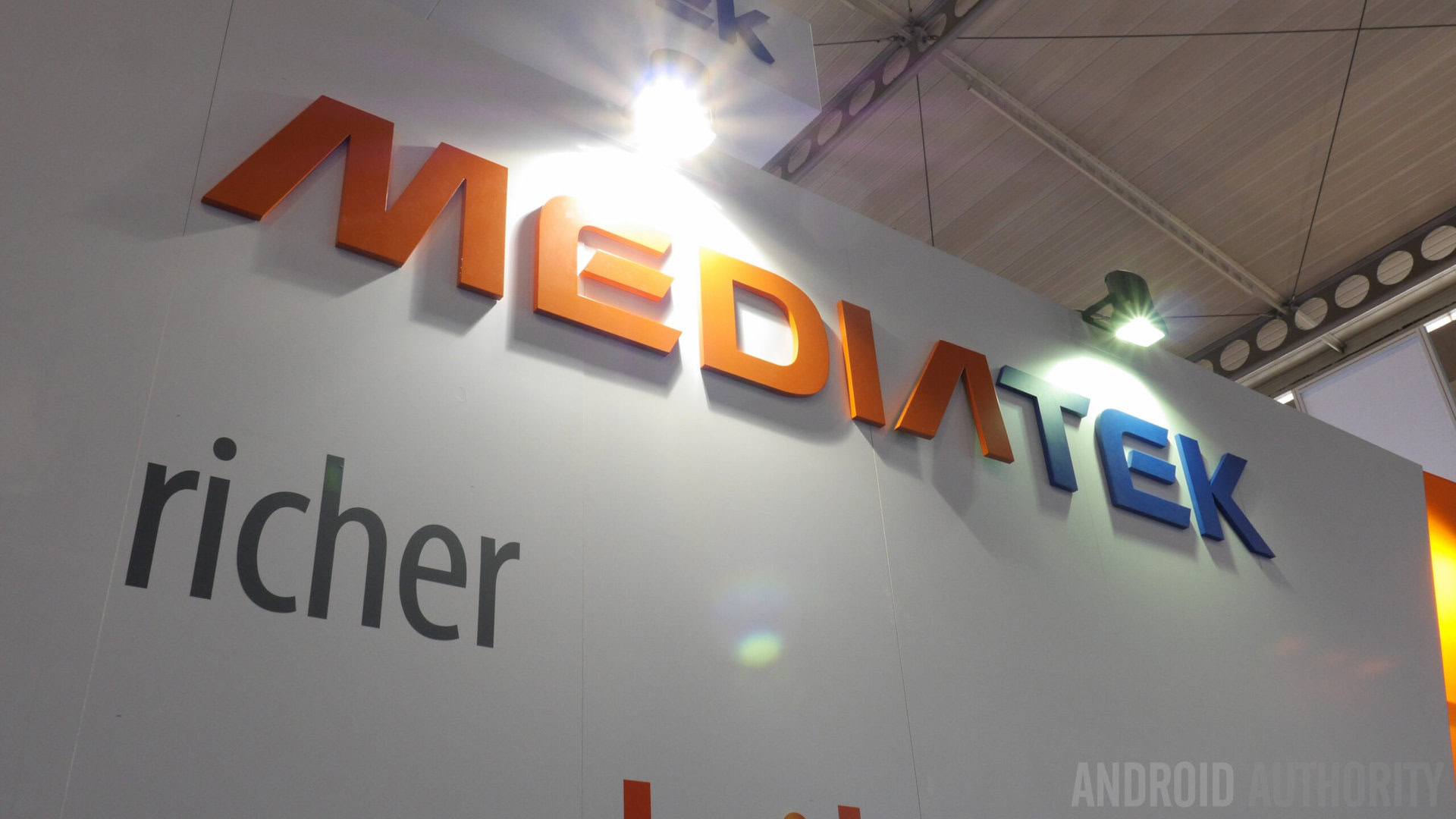Affiliate links on Android Authority may earn us a commission. Learn more.
Xiaomi Surge S1: more than your typical mid-range SoC

The announcement of Xiaomi’s first in-house mobile processor, the Surge S1, is big news not just for the company, but for the processor industry too. Xiaomi joins the ranks of Qualcomm, MediaTek, Samsung, HUAWEI HiSilicon, Apple, and a few others, in the market for mobile chips, throwing in additional competition that could be a boon for us consumers.
What makes Xiaomi’s announcement particularly important is its share of the global smartphone market. Xiaomi is the fourth largest brand in the huge Chinese market and a growing influence in India, which means that there are millions of potential customers for its in-house SoC. A little worryingly for Qualcomm and MediaTek, they could lose Xiaomi as a customer in these markets too.

At the moment, the Surge S1 is only one chip and a mid-range one at that, which isn’t going to worry the performance kings. However, the super-mid market is a big segment these days and we could certainly see more powerful processors from Xiaomi in the future which could shake up the market.
With this all in mind, let’s stack up the chip against some of its closest competitors and see if Xiaomi is on the right track. I’ve picked out the latest mid-tier Qualcomm 626, MediaTek Helio P25, and HiSilicon Kirin 655 as the closest likely rivals to the Surge S1, both in terms of performance and target products. Let’s dive in.
| Xiaomi Surge S1 | Qualcomm Snapdragon 626 | MediaTek Helio P25 | HiSilicon Kirin 655 | |
|---|---|---|---|---|
CPU | Xiaomi Surge S1 4x Cortex-A53 @ 2.2GHz 4x Cortex-A53 @ 1.4GHz | Qualcomm Snapdragon 626 8x Cortex-A53 @ 2.2GHz | MediaTek Helio P25 8x Cortex-A53 @ 2.5GHz | HiSilicon Kirin 655 4x Cortex-A53 @ 2.1GHz 4x Cortex-A53 @ 1.7GHz |
GPU | Xiaomi Surge S1 Mali-T860 MP4 | Qualcomm Snapdragon 626 Adreno 506 | MediaTek Helio P25 Mali-T880 MP2 | HiSilicon Kirin 655 Malit-T830 MP2 |
RAM | Xiaomi Surge S1 2x 32-bit LPDDR3 @ 933MHz | Qualcomm Snapdragon 626 2x 32-bit LPDDR3 @ 933MHz | MediaTek Helio P25 2x LPDDR4X @ 1600MHz | HiSilicon Kirin 655 2x 32-bit LPDDR3 @ 933MHz |
Flash | Xiaomi Surge S1 eMMC 5.0 | Qualcomm Snapdragon 626 eMMC 5.1 | MediaTek Helio P25 eMMC 5.1 | HiSilicon Kirin 655 eMMC 5.1 |
DSP / co-core | Xiaomi Surge S1 32-bit DSP | Qualcomm Snapdragon 626 Hexagon DSP | MediaTek Helio P25 N/A | HiSilicon Kirin 655 i5 co-processor |
Camera support | Xiaomi Surge S1 36MP, Dual ISP (14-bit) | Qualcomm Snapdragon 626 24MP, Dual ISP (12-bit?) | MediaTek Helio P25 24MP single or 2x 13MP dual (12-bit) | HiSilicon Kirin 655 Dual ISP |
Modem | Xiaomi Surge S1 150Mbps down 50Mbps up | Qualcomm Snapdragon 626 300Mbps down 150Mbps up | MediaTek Helio P25 300Mbps down 50Mbps up | HiSilicon Kirin 655 300Mbps down 50Mbps up |
Video | Xiaomi Surge S1 4k 30fps playback & capture | Qualcomm Snapdragon 626 4k 30fps playback & capture | MediaTek Helio P25 4k 30fps playback & capture | HiSilicon Kirin 655 4k 30fps playback & capture |
Process | Xiaomi Surge S1 28nm HPC | Qualcomm Snapdragon 626 14nm FinFET | MediaTek Helio P25 16nm FinFET | HiSilicon Kirin 655 16nm FinFET |
Right away we can spot a common theme on the CPU side across all of these mid-tier chips; varying takes on an octa-core ARM Cortex-A53 configuration. Although way behind the flagship tier, these energy efficient CPU cores can certainly offer a smooth performance when there’s enough of them. The Surge S1’s peak clock speeds quite happily sit right in the pack, so CPU performance should be near identical across the selection here.
Xiaomi's Surge S1 is being built on an older 28nm HPC process, which raises some concerns regarding energy consumption and peak performance sustainability compared with smaller 16nm chips.
However, Xiaomi’s Surge S1 is being built on an older 28nm HPC process, rather than the 16 / 14nm FinFET technology picked up in the latest competing chips. This raises some questions about energy consumption and peak performance sustainability compared with these smaller 16nm chips. However, the S1’s second cluster of A53s features a lower peak clock, which might help to sidestep this drawback at the expense of some performance.
The Surge S1 also features a very similar memory setup to the other SoCs on our list. Dual 32-bit channels of LPDDR3 at 933MHz is the standard, and it’s only MediaTek’s newly announced Helio P25 that goes one better here with LPDDR4X. LPDDR4X is a boon not only for faster transfer speeds, but it also has a low power mode that can save on battery life. While LPDDR3 is fast enough for loading up apps and the like, memory bandwidth is a more important factor when gaming or recording high resolution video, and the Helio P25 could have an edge in some situations as a result.
Speaking of gaming, we start to see Xiaomi’s chip stand out here as it features a fast ARM Mali-T860 design configured in an quad-cluster configuration. This gives the chip double the core count over the Helio P25 and is based on a much faster core than the Kirin 655’s Mali-T830, so the chip should easily win out here. It’s tougher to compare this on paper to the Snapdragon 626’s Adreno 506, but a selection of benchmarks from existing handsets suggests somewhere around a 50 percent performance advantage for the S1.
Xiaomi also seems pretty confident in its GPU setup, and posted its own GFXBench result (above, right) in its announcement that shows a large gap between the S1 and some of the older competitors on the market. Of course, we should take this with a little salt, but the data out there definitely suggests that the S1 could have a strong advantage, even over the newer chips in our comparison.
On the performance side then, the Surge S1 looks like a strong competitor against other mid-tier chips on the market, and the boost to GPU performance could end up helping to bridge the gap with more expensive flagship SoCs. That said, we’ll want to go hands-on before drawing any definitive conclusions, and that old 28nm manufacturing process does have drawbacks that are tough to ignore.

We all know that extra features are usually the differentiating factor when it comes to SoCs these days, and Xiaomi has included a few tricks of its own to compete with the feature set of its well established rivals. Like its competitors, the Surge S1 supports fast charging, at 9V/2A, which rivals Qualcomm’s Quick Charge 3.0 inside the Snapdragon 626.
Xiaomi has also designed an in-house dual ISP, which presumable supports two cameras although that hasn’t been stated. However, we do know that the S1 ups its ISP to support 14-bit data, up from the usual 12-bit that seems common in this tier. This increase in throughput supports higher resolution sensors that match what we see from some flagship chips. Xiaomi also states that this powerful ISP can be used for some smart noise reduction algorithms, although it’s impossible to say if this is better than its rivals at this stage. With Qualcomm, MediaTek, and HiSilicon all now supporting dual cameras in their low-cost chips, this is a very competitive move by Xiaomi.
Heterogeneous compute is also becoming more important in order to support advanced features on a small power budget, and a number of SoC manufacturers are including dedicated DSP units in their latest chips. Qualcomm has Hexagon, Kirin uses its i5 co-processor, and Xiaomi has implemented a 32-bit DSP which it uses for high quality voice recording and processing. Performance wise, we can’t know how much of a difference these chips make, but they’re mostly about power saving and offloading common background tasks to lower power processors.

Xiaomi has implemented an impressive dual ISP, DSP and fast charging units into the Surge S1, but the Category 4 LTE modem is a little behind the curve.
Unfortunately, Xiaomi hasn’t spilled the details on the chip’s interconnect, so we don’t know how fast and closely integrated all of these processing units are and exactly how capable its heterogeneous compute capabilities are. Still, this further demonstrates that Xiaomi is opting for similar optimizations and features as seen by other major SoC vendors, and is a promising sign for future generations of Surge.
The last feature we’re going to look at is modem technology. Unfortunately Xiaomi’s Category 4 LTE modem is a little behind the times here. The peak download and upload speeds are still far ahead of what most carriers can provide and the chip does support 2x carrier aggregation. However, Category 4 LTE doesn’t support MIMO or 64QAM, meaning that the chip is unable to fully utilize more advanced networks and might see slower speeds in poorer areas of coverage, such as at the cell edge. This isn’t to say that the S1 will provide a poor 4G experience, just that other vendors have moved on to better technology.
Wrap up
Even though Xiaomi hasn’t targeted the flagship market with its debut SoC, the Surge S1 looks to offer impressive performance for affordable smartphones, and appears to hold its own against the latest announcements for established manufacturers. The chip is not without its drawbacks, but a strong feature set that rivals other options out there ensures that Xiaomi will be able to produce a variety of handsets from this single design.
The older LTE modem and 28nm manufacturing process are perhaps the S1’s biggest problems, but these issues will likely be addressed in any future Xiaomi chips. For a debut, a 28nm design offers high yields on a thoroughly refined process at a lower cost than cutting edge 16nm FinFet, and on balance this seems like a sensible decision for a first manufacturing run. If you look at the performance offered by the 1,499 Yuan ($220 USD) Mi 5c, this seems like a quite acceptable trade-off.
The Surge S1 is a promising development from Xiaomi and an exciting sign of things that may come in the future. Are you impressed by Xiaomi’s debut into the competitive mobile SoC market?